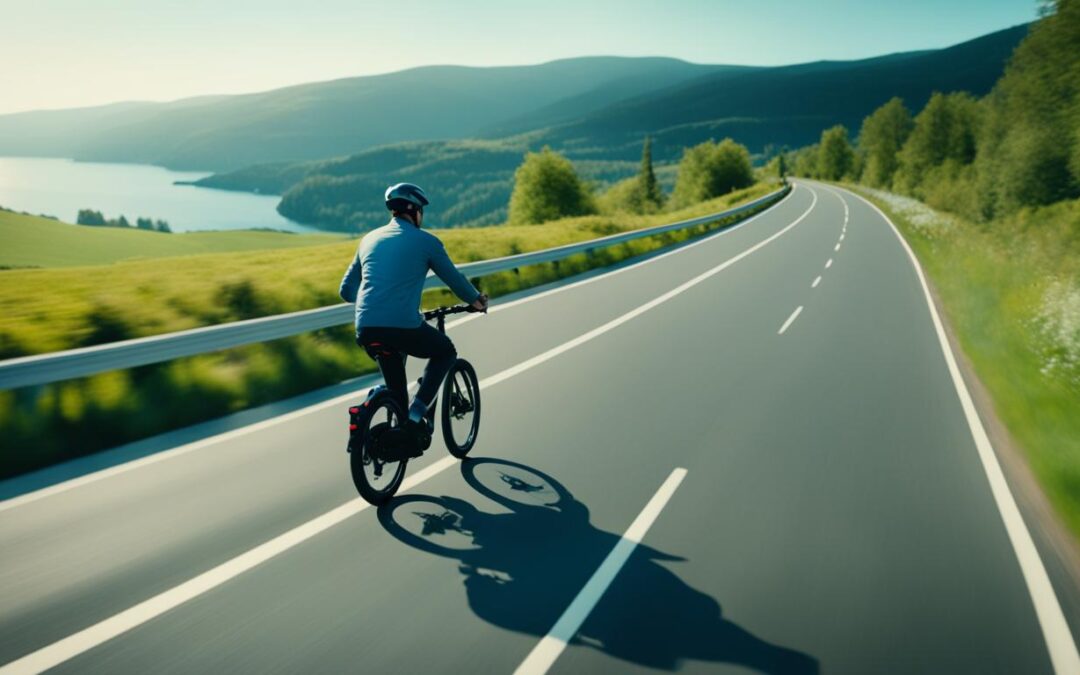If you’re considering investing in an electric bike, you may be wondering how far it can go without pedaling. The range of an electric bicycle refers to the distance you can ride in one battery charge.
There are several factors that can impact the range of an electric bike. These include the total weight of the load, average riding speed, riding position, tire pressure and type, terrain and hill grade, wind conditions, road quality and bumps, outside temperature, pedal capability and fitness, battery type and size, and age of the battery.
While all these factors come into play, there are ways to maximize the battery life and range of your electric bike. By utilizing pedal assist, choosing the correct gear, and avoiding rough terrain, you can go the extra mile.
Key Takeaways:
- Factors such as weight, speed, tire pressure, and gear selection can impact the efficiency and range of an electric bike.
- Pedal Electric offers two models, The Core (30-50 miles) and The AWD III (40-75 miles), with longer ranges than average bikes.
- Utilizing pedal assist, choosing the correct gear, and avoiding rough terrain can help maximize the battery life and range of an electric bike.
- The range of an electric bike without pedaling varies, but riders can take steps to optimize their e-bike’s maximum range.
- By understanding the factors that affect range and making adjustments, you can make the most out of your electric bike.
Factors Affecting E-Bike Range
When it comes to electric bikes, the range can vary based on several factors. Understanding these factors can help you determine how far your electric bike can go without pedaling and how to optimize your bike’s mileage.
Factors that Impact E-Bike Range:
- Speed: The faster you ride, the more energy your electric bike consumes, which can reduce its range.
- Rider Weight: Heavier riders may experience slightly reduced range compared to lighter riders.
- Terrain Style: Riding on hilly terrains or rough surfaces requires more power, impacting your e-bike’s battery life.
- Wind Conditions: Strong headwinds can increase resistance and decrease your e-bike’s range.
- Tire Choice: Different tire types and pressures can affect rolling resistance, which in turn can impact your e-bike’s mileage.
The presence or absence of a hand throttle on your electric bike can also affect its range. Using the throttle alone drains the battery quicker compared to using pedal assist, which relies on your pedaling efforts along with the motor’s support.
You can estimate your electric bike’s range by dividing the watt hour capacity of the battery by an average efficiency number. For throttle-only riding, the average efficiency is around 25 Wh/mi, while pedal assist riding can achieve an average efficiency of 15 Wh/mi. Keep in mind that these numbers can be adjusted based on factors such as rider weight and terrain.
To give your electric bike the best autonomy without pedaling, consider adjusting your riding style, maintaining an optimal weight, and choosing terrain-friendly routes. These measures can help you maximize your electric bike’s range and enjoy longer rides without worrying about running out of battery.
| Factor | Impact on E-Bike Range |
|---|---|
| Speed | Higher speeds consume more energy, resulting in reduced range. |
| Rider Weight | Heavier riders may experience slightly reduced range compared to lighter riders. |
| Terrain Style | Hilly or rough terrains require more power, decreasing your e-bike’s battery life. |
| Wind Conditions | Strong headwinds increase resistance, reducing your e-bike’s range. |
| Tire Choice | Different tire types and pressures impact rolling resistance, affecting your e-bike’s mileage. |
| Throttle Usage | Using the throttle alone drains the battery quicker than pedal assist, affecting range. |
Maximizing E-Bike Range
To maximize the range of an electric bike without pedaling, there are several strategies you can employ:
- Go easy on the throttle: Opting for a gentle throttle usage conserves battery life, allowing you to cover more distance without draining the power source.
- Pedal while accelerating: Combine the power of pedaling with the assistance of the electric motor to maximize efficiency and extend the range of your e-bike.
- Pump your tires to the correct pressure: Maintaining the recommended tire pressure reduces rolling resistance and makes your ride more energy-efficient, enabling you to travel farther with ease.
- Coast and avoid rough terrain: Take advantage of downhill gradients to coast and minimize the energy being used. Avoiding rough and uneven terrain also helps conserve the battery and increase your e-bike’s range.
- Ride in the correct gear: Find the optimal gear for your riding conditions and shift frequently to maintain a comfortable and efficient pedaling rhythm. This not only conserves battery power but also extends the range of your electric bike.
By incorporating these strategies into your e-bike riding routine, you can significantly extend the maximum range of your electric bike without pedaling.
Remember, pairing pedaling with electric assistance is key to achieving the greatest range. Embrace these techniques to make the most of your electric bike’s capabilities and enjoy longer rides without worrying about running out of power.
Calculating Estimated Range
When it comes to determining how long an electric bike can last without pedaling, an important factor to consider is the estimated range of the battery. This can be calculated by dividing the watt hour capacity of the battery by an average efficiency number. Let’s explore more about estimating the range of electric bikes.
Throttle-only riding typically has an average efficiency of 25 Wh/mi, while pedal assist riding can have an average efficiency of 15 Wh/mi. These numbers serve as a general guide, but keep in mind that different factors can influence the actual range.
For example, riders can adjust these efficiency numbers based on their weight and the terrain they ride on. Heavier riders may experience slightly lower efficiency, while lighter riders may achieve greater efficiency and longer range.
It’s worth mentioning that strong pedalers can further extend the range by utilizing lower pedal assist modes and adding their own pedal power. By combining the electric motor’s assistance with your pedaling efforts, you can maximize the battery life and extend the overall range of the electric bike.
However, it’s important to note that extreme range ratings provided by manufacturers are often based on ideal conditions with significant pedal input. In real-world scenarios, you may not achieve the exact range stated by the manufacturer. Nevertheless, understanding how to calculate the estimated range based on average efficiency numbers can give you a good starting point.
“The estimated range of an electric bike greatly relies on various factors, including the capacity of the battery and the efficiency of pedaling. By considering these factors and adjusting the numbers based on your weight and terrain, you can get a better idea of how far your electric bike can go without pedaling.”
Estimated Range Calculation Example
Here’s an example to help you understand how to calculate the estimated range of an electric bike:
| Battery Capacity (Wh) | Efficiency (Wh/mi) | Estimated Range (mi) |
|---|---|---|
| 500 | 25 | 20 |
| 500 | 15 | 33.33 |
In this example, if you have an electric bike with a battery capacity of 500 watt hours and you ride using throttle-only mode with an average efficiency of 25 Wh/mi, you can expect an estimated range of approximately 20 miles.
On the other hand, if you ride using pedal assist mode with an average efficiency of 15 Wh/mi, the estimated range increases to approximately 33.33 miles.
Remember, these calculations are based on average efficiency numbers and can vary based on individual factors such as weight, riding style, and terrain. It’s always a good idea to test the range under real-world conditions to get a more accurate estimate.
Now that you know how to calculate the estimated range of an electric bike, you can make more informed decisions and plan your rides accordingly.
Conclusion
In conclusion, the range of an electric bike without pedaling depends on several key factors, including the battery capacity, rider weight, riding style, and terrain. These factors can have a significant impact on the efficiency and overall distance that an electric bike can travel.
Factors such as weight, speed, tire pressure, and gear selection all play a role in determining the autonomy and range of an electric bike. By understanding and optimizing these variables, riders can maximize the battery life and distance covered without pedaling.
It is important for riders to consider their individual factors and test the range under real-world conditions to get a more accurate estimate. Every rider and bike combination is unique, and factors such as rider fitness and energy exertion can further impact the distance an electric bike can go without pedaling.
In summary, while the range of an electric bike without pedaling can vary, riders have the ability to take steps to optimize their e-bike’s maximum range. By paying attention to battery capacity, rider weight, riding style, and terrain, riders can achieve greater autonomy and distance without pedaling, enhancing their overall e-bike experience.
FAQ
How far will an electric bike go without pedaling?
The range of an electric bicycle refers to the distance you can ride in one battery charge.
What factors affect the range of an electric bike without pedaling?
Factors that impact the range include the total weight of the load, average riding speed, riding position, tire pressure and type, terrain and hill grade, wind conditions, road quality and bumps, outside temperature, pedal capability and fitness, battery type and size, and age of the battery.
How can I maximize the range of my electric bike without pedaling?
To maximize the battery life and range of an electric bike, you can utilize pedal assist, choose the correct gear, and avoid rough terrain.
How can I calculate the estimated range of an electric bike without pedaling?
Riders can estimate an electric bike’s range by dividing the watt hour capacity of the battery by an average efficiency number in Wh/mi or Wh/km.
Can I increase the range of an electric bike without pedaling by adjusting my riding style?
Yes, you can make adjustments to go easy on the throttle, pedal while accelerating, pump your tires to the correct pressure, coast and avoid rough terrain, and ride in the correct gear to maximize the range.
What is the maximum range of an electric bike without pedaling?
The maximum range of an electric bike without pedaling can vary based on factors such as speed, rider weight, terrain style, wind conditions, and tire choice.

